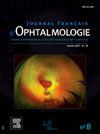Clinical utility of ultra-widefield indocyanine green angiography in posterior uveitis
IF 1.1
4区 医学
Q3 OPHTHALMOLOGY
引用次数: 0
Abstract
Purpose
To describe the ultrawide-field indocyanine green angiography (UWF-ICGA) findings in a cohort of patients with uveitis and analyze the potential advantages of ultrawide-field angiography.
Methods
An observational, retrospective, single-center study was conducted. All patients with posterior uveitis or panuveitis who underwent UWF-ICGA at Hospital Clínic de Barcelona (Spain) were included. Images were reviewed by three different ophthalmologists and graded based on the Tugal-Tukun score, with particular attention to peripheral findings.
Results
Forty patients (79 eyes) were included. The mean age was 52 years; twenty-nine were female (72.5%). The most frequent uveitis etiology was birdshot chorioretinopathy. Peripheral findings were found in 25 patients (62.5%). The most frequent finding was hypofluorescent dark dots (40 eyes, 50.6%) followed by early stromal vessel hyperfluorescence (32 eyes, 40.5%). Tugal-Tutkun scoring was between 0 and 3 in 20 patients (50%), corresponding to the clinical activity of the uveitis at that time. Two patients showed subclinical lesions in the fellow eye on UWF-ICGA that were not apparent on funduscopic examination. Immunosuppressive treatment was initiated based on the ICGA findings in these patients. In seven patients (17.5%), UWF-ICGA directly influenced the diagnosis and therapeutic management.
Conclusion
Ultra-wide field systems allow detection of peripheral lesions that could go unnoticed with conventional imaging systems. In our cohort, clinical uveitis activity generally correlated with the Tugal-Tutkun angiographic score. UWF-ICGA is a useful tool for the diagnosis and follow-up of uveitis. It can be useful for making therapeutic decisions in some patients.
Objectif
Décrire les observations de l’angiographie au vert d’indocyanine ultra-grand champ (UWF-ICGA) dans une cohorte de patients atteints d’uvéite et analyser les avantages potentiels du champ ultra-large.
Méthodes
Une étude observationnelle, rétrospective et monocentrique a été réalisée. Tous les patients atteints d’uvéite postérieure ou de panuvéite ayant subi une UWF-ICGA à l’Hôpital Clinique de Barcelone (Espagne) ont été inclus. Les images ont été examinées par trois ophtalmologistes différents et notées selon le score de Tugal-Tutkun, en portant une attention particulière aux observations périphériques.
Résultats
Quarante patients (79 yeux) ont été inclus. L’âge moyen était de 52 ans, vingt-neuf patients étaient des femmes (72,5 %). L’étiologie de l’uvéite la plus fréquente était la choriorétinopathie Birdshot. Des observations périphériques ont été relevées chez 25 patients (62,5 %). L’observation la plus fréquente était celle de points sombres hypofluorescents (40 yeux, 50,6 %), suivie par une hyperfluorescence vasculaire stromale précoce (32 yeux, 40,5 %). Le score de Tugal-Tutkun se situait entre 0 et 3 chez 20 patients (50 %), ce qui correspondait à l’activité clinique de l’uvéite à ce moment-là. Deux patients ont présenté des lésions infracliniques à l’œil controlatéral visibles en UWF-ICGA qui n’étaient pas présentes en fondoscopie. Un traitement immunosuppresseur a été initié suite aux observations ICGA chez ces patients. Chez sept patients (17,5 %), l’UWF-ICGA a directement influencé le diagnostic et la gestion thérapeutique.
Conclusion
Les systèmes ultra-grand champ permettent de détecter des lésions périphériques qui pourraient passer inaperçues avec les systèmes d’imagerie conventionnels. Dans notre cohorte, l’activité clinique de l’uvéite correspondait généralement au score angiographique de Tugal-Tutkun. L’UWF-ICGA est un outil utile pour le diagnostic et le suivi de l’uvéite et peut être utile pour prendre des décisions thérapeutiques chez certains patients.
超宽视场吲哚菁绿血管造影在后葡萄膜炎中的临床应用
目的描述一组葡萄膜炎患者的超宽场吲哚菁绿血管造影(UWF-ICGA)结果,分析超宽场血管造影的潜在优势。方法采用观察性、回顾性、单中心研究。所有在西班牙Clínic de Barcelona医院接受UWF-ICGA治疗的后葡萄膜炎或全葡萄膜炎患者均被纳入研究。图像由三位不同的眼科医生检查,并根据Tugal-Tukun评分进行评分,特别注意外周表现。结果纳入患者40例(79眼)。平均年龄52岁;女性29例(72.5%)。葡萄膜炎最常见的病因是鸟射性脉络膜视网膜病变。25例(62.5%)患者出现外周病变。最常见的表现是低荧光黑点(40眼,50.6%),其次是早期间质血管高荧光(32眼,40.5%)。20例患者(50%)的Tugal-Tutkun评分在0 - 3之间,与当时葡萄膜炎的临床活动性相对应。2例患者侧眼UWF-ICGA显示亚临床病变,而眼底检查不明显。免疫抑制治疗是基于这些患者的ICGA发现。7例(17.5%)患者UWF-ICGA直接影响诊断和治疗管理。结论超宽视场系统可以检测到常规成像系统无法发现的周围病变。在我们的队列中,临床葡萄膜炎活动通常与Tugal-Tutkun血管造影评分相关。UWF-ICGA是诊断和随访葡萄膜炎的有效工具。它对某些患者的治疗决策是有用的。目的:观察血管造影术对吲哚氰胺超大剂量(UWF-ICGA)患者的影响,并对其进行分析。3 . msamthodesune是指单纯的、观察的、单中心的和单纯的。我们的患者尝试过“UWF-ICGA”(西班牙)内的“UWF-ICGA”(西班牙)内的“UWF-ICGA”(西班牙)内的“UWF-ICGA”(西班牙)内的“UWF-ICGA”,其中不包括“UWF-ICGA”。里面的图像高频考生par三ophtalmologistes不同等注意根据le得分de Tugal-Tutkun en创造一个关注particuliere辅助观察环城公路。* * * * * * * * * * * * * * * * * * * * * * * * * * * *L ' 莫因病(莫因病)的病例为52例,未确诊的病例为72,5 %。我的“升职升职”我的“升职升职”我的“升职升职”我的“升职升职”25例患者(62.5%)的观察结果显示,这些患者与其他患者(62.5%)的病情有关。L 'observation la + fracimquente cv (40 %, 50.6%), a 'observation la + fracimente cv(32 %, 40.5%)。Le score de Tugal-Tutkun se情况中心0 / 3 / 20例患者(50%),ce qui correspondile ' activitvitel诊所de l ' uvsamite - lous。2例患者不能观察到单纯的变性,不能观察到单纯的变性,不能观察到单纯的变性,不能观察到单纯的变性,不能观察到单纯的变性。治疗性免疫抑制剂和免疫细胞瘤起始期对患者进行了观察。在9例患者中(17.5%),l 'UWF-ICGA指示影响其诊断和妊娠期的预后。结论:系统的超大尺度渗透,系统系统的超尺度渗透,系统系统的超尺度渗透,系统系统的超尺度渗透,系统系统的超尺度渗透,系统系统的超尺度渗透,系统系统的超尺度渗透,系统系统的超尺度渗透,系统系统的超尺度渗透。Dans notre cohorte, l ' activitclinique de l ' uvsamite correspondans ' acvit。L 'UWF-ICGA是一种非常有效的诊断方法,它可以帮助患者诊断出患有某种疾病的患者,也可以帮助患者诊断患有某种疾病的患者。
本文章由计算机程序翻译,如有差异,请以英文原文为准。
求助全文
约1分钟内获得全文
求助全文
来源期刊
CiteScore
1.10
自引率
8.30%
发文量
317
审稿时长
49 days
期刊介绍:
The Journal français d''ophtalmologie, official publication of the French Society of Ophthalmology, serves the French Speaking Community by publishing excellent research articles, communications of the French Society of Ophthalmology, in-depth reviews, position papers, letters received by the editor and a rich image bank in each issue. The scientific quality is guaranteed through unbiased peer-review, and the journal is member of the Committee of Publication Ethics (COPE). The editors strongly discourage editorial misconduct and in particular if duplicative text from published sources is identified without proper citation, the submission will not be considered for peer review and returned to the authors or immediately rejected.

 求助内容:
求助内容: 应助结果提醒方式:
应助结果提醒方式:


